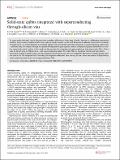Solid-state qubits integrated with superconducting through-silicon vias
Author(s)
Yost, DRW; Schwartz, ME; Mallek, J; Rosenberg, D; Stull, C; Yoder, JL; Calusine, G; Cook, M; Das, R; Day, AL; Golden, EB; Kim, DK; Melville, A; Niedzielski, BM; Woods, W; Kerman, AJ; Oliver, WD; ... Show more Show less
DownloadPublished version (1.250Mb)
Publisher with Creative Commons License
Publisher with Creative Commons License
Creative Commons Attribution
Terms of use
Metadata
Show full item recordAbstract
© 2020, The Author(s). As superconducting qubit circuits become more complex, addressing a large array of qubits becomes a challenging engineering problem. Dense arrays of qubits benefit from, and may require, access via the third dimension to alleviate interconnect crowding. Through-silicon vias (TSVs) represent a promising approach to three-dimensional (3D) integration in superconducting qubit arrays—provided they are compact enough to support densely-packed qubit systems without compromising qubit performance or low-loss signal and control routing. In this work, we demonstrate the integration of superconducting, high-aspect ratio TSVs—10 μm wide by 20 μm long by 200 μm deep—with superconducting qubits. We utilize TSVs for baseband control and high-fidelity microwave readout of qubits using a two-chip, bump-bonded architecture. We also validate the fabrication of qubits directly upon the surface of a TSV-integrated chip. These key 3D-integration milestones pave the way for the control and readout of high-density superconducting qubit arrays using superconducting TSVs.
Date issued
2020Department
Lincoln Laboratory; Massachusetts Institute of Technology. Research Laboratory of ElectronicsJournal
npj Quantum Information
Publisher
Springer Science and Business Media LLC